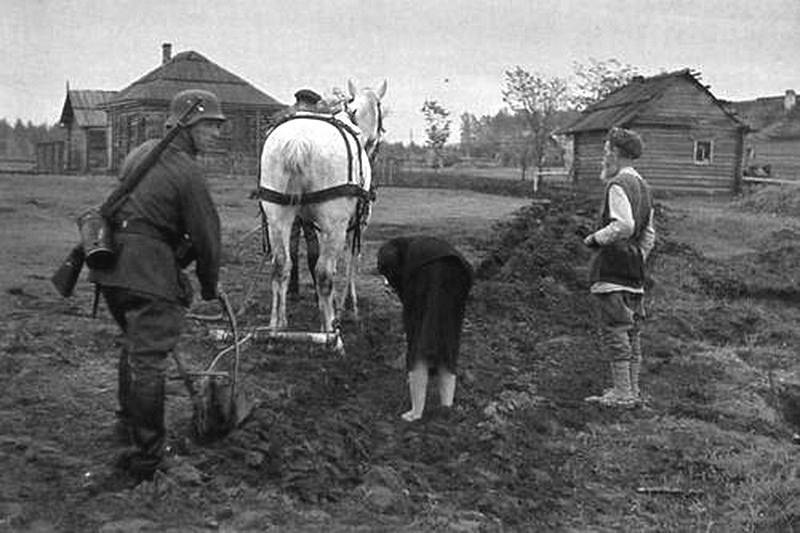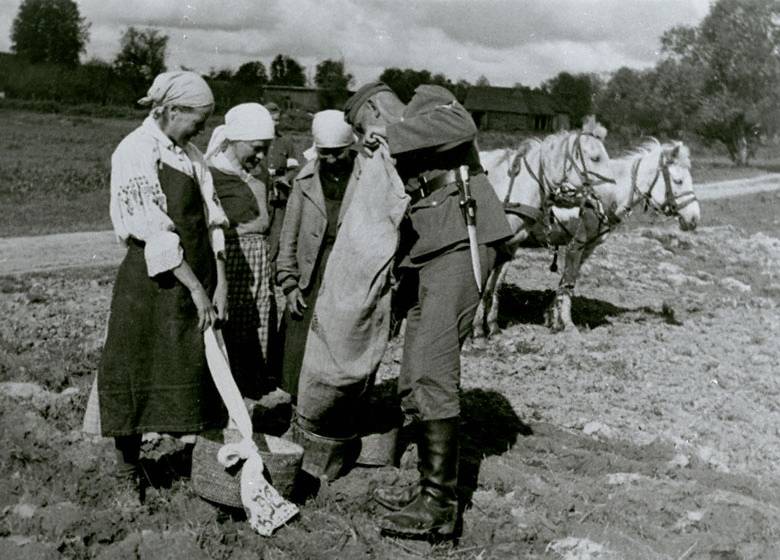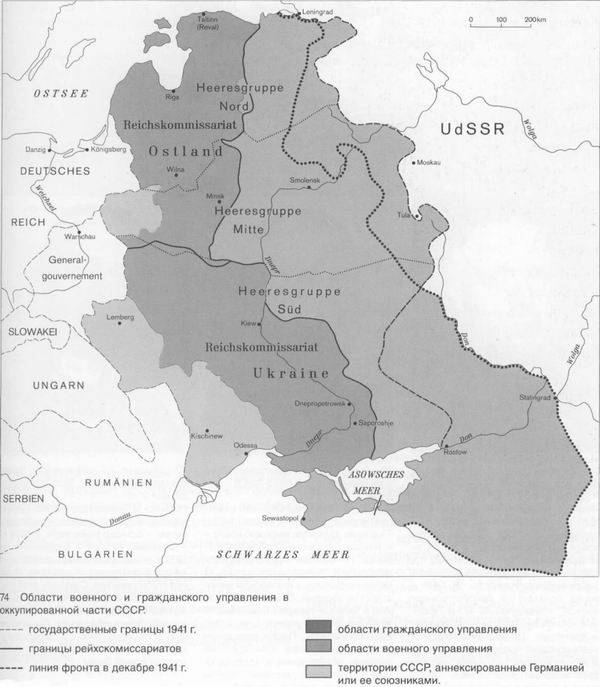Harvests and procurement of bread in the occupied territories of the USSR

In the course of my recent searches in the archives, I managed to find several documents that shed some light on the scale of grain production and grain procurement in the territories of the USSR occupied by the Germans. These were several certificates compiled by the Imperial Statistical Office for the Reich Ministry of Economy, which reflected the size of grain harvesting, supplies for the needs of the Wehrmacht and export to Germany.
Judging by the use sheet, this case was watched by a dozen researchers who used this data in their works, in any case, I saw some numbers and links to documents in the publications I looked at earlier. However, these researchers ignored the very interesting nuances of these documents, which make it possible to assess the state of affairs in the grain farming of the occupied regions in some dynamics and results. This is partly due to the fact that in order to draw conclusions, one must have good experience in researching the agricultural economy of the USSR and be able to derive others from some figures by the calculation method, which was widely used in economic planning at that time. Researchers who took up the economic history, as a rule, they did not have such experience. I have such experience, and it has already led me more than once to interesting conclusions, sometimes overturning established ideas.
Information about German grain procurements
On August 9, 1943, a small, but very informative certificate was drawn up in Berlin about the supply of agricultural products for 1941/42 and 1942/43. The German business year began on August 1 and ended on July 31 of the following year, thus covering the collection and use of the harvest of spring and winter crops. This certificate is supplemented by other documents: a certificate of deliveries for July 31, 1943 (in the previous document, data for 1942/43 are given until May 31, 1943), a certificate of deliveries for March 31, 1944. If in the first document data are given for each financial year, then the last two documents provide information on an accrual basis. However, it will not be so difficult to calculate exactly how much accounted for the full year 1942/43 and 1943/44. That is, we have information about the harvests from the crops of 1941, 1942 and 1943. The Germans could not collect the harvest of 1944, because in the spring of 1944 they lost the territory of the Reichskommissariat Ukraine, and in the summer of 1944 they lost the most important agrarian part of the Reichskommissariat Ostland - Belarus.
This is perhaps the most complete data, and one can hardly count on their refinement. But who knows, archives sometimes give surprises.
Procurement data can be presented in the following table (in thousands of tons):

The sign (*) denotes the data obtained by calculation, by subtracting the cumulative total of deliveries from previous years from the given data. Data on supplies to the Wehrmacht and exports to Germany in 1943/44 are inaccurate, since they were obtained from generalized data from the beginning of the occupation until March 31, 1944 by subtracting data for 1941/42 and 1942/43, and for the second year it was not taken into account 537 thousand tons of grain harvested in June-July 1943. How they were distributed was not reflected in the documents; one can only assume that most of this grain was supplied to the Wehrmacht, and the volume of supplies to the troops in 1943/44 reached about 2 million tons or a little more. But in general, this does not particularly affect the overall picture.
The certificate does not indicate what is meant by deliveries to the Wehrmacht, but according to the content of the document, most likely, it means the supply of the troops of the Eastern Front and stationed in the occupied territory of the USSR.
The Wehrmacht, as you know, tried to fight on the grass. However, the certificate dated August 9, 1943 indicates the share of the eastern occupied regions in supplies to the troops. For 1941/42 - 77%, for 1942/43 - 78%. If I understand the value of this indicator correctly (it would be better to clarify it from other documents; perhaps this information will be found later), then in 1941/42 the German troops on the Eastern Front received about 376 thousand tons from Germany and other occupied regions, and in 1942/43 - 599 thousand tons of grain, that is, about a fifth of its annual consumption. The Wehrmacht subsisted mostly on occupational agriculture, but not entirely.
Ukraine is the main source of food
Much or little grain was procured, and what was the relation to production? It is not easy to answer this question now, since I have not yet been able to find German statistics on the size of crops and the average yield in the territories occupied by them. If there were such information, then the calculation of the grain balance would be a relatively simple task.
Until these data are found (and there are some doubts that they were actually collected), one can resort to preliminary, rough estimates. The certificate dated August 9, 1943 indicates the share of the Reichskommissariat Ukraine in the supply of grain: 1941/42 - 77%, 1942/43 - 78%. That is, this Reichskommissariat delivered 1941 thousand tons in 42/1263 and 1942 thousand tons in 43/2550. The rest was distributed between the Reichskommissariat Ostland, as well as the territories of the west of the RSFSR, the left-bank Ukraine, the Caucasus and Crimea, which were in the zone of responsibility of Army Groups North, Center and South under the control of the economic headquarters of the Army Groups.

In the German data, there are statistics on the distribution of the total amount of food (including grain, potatoes, meat, sunflower, hay and straw) by sources for 1942/43 (excluding harvests for June-July 1943):
Total - 6099,8 thousand tons.
Reichskommissariat Ukraine - 3040,6 thousand tons.
Household staff "Center" - 816,5 thousand tons.
Household staff "South" - 763,9 thousand tons.
Reichskommissariat Ostland (excluding Belarus) - 683,5 thousand tons.
Caucasus - 371,2 thousand tons.
Household staff "North" - 263,7 thousand tons.
District of Belarus - 160,2 thousand tons (RGVA, f. 1458K, op. 3, d. 77, l. 92).
These data show the comparative value for Germans of different occupied territories. But it is not yet possible to single out grain crops from them. Belarus took the last place in this list because in the summer and autumn of 1942 the partisans staged a defeat of the occupation agriculture there.
However, until more detailed data are obtained, a comparison can be made for Ukraine by comparing the German data with the data on pre-war grain deliveries. This will make it possible to understand the state of agriculture under the occupation not in the “Germans plundered everything” format, but on the basis of more or less objective data.
There are two difficulties that deserve special mention. Firstly, the Reichskommissariat Ukraine in its territory did not coincide with the Ukrainian SSR. It consisted mainly of Right-Bank Ukraine with a small western part of the Left-Bank Ukraine. In addition, most of Western Ukraine was separated and annexed to the General Government of the occupied territories of Poland. Also, the Moldavian ASSR (within the borders of 1939), along with Bessarabia, was annexed to Romania, and almost the entire Odessa region of the Ukrainian SSR entered the Romanian occupation zone known as Transnistria. It is very difficult to carry out an exact comparison of territories, since the Germans divided the territory at their discretion, and the pre-war regions of the Ukrainian SSR were repeatedly subjected to reorganization and disaggregation, which affects the comparability of statistics. Here you need to compare the regions, but so far there is no such possibility. For a rough estimate, it can be assumed that the territory of the Reichskommissariat Ukraine more or less corresponded to the territory of the Kiev, Vinnitsa and Dnepropetrovsk regions of the Ukrainian SSR within the borders of 1934.

Second, with what to compare, what state of pre-war agriculture can be taken as the starting point of comparison? The figures for the late 1930s are not very suitable, since agriculture was already largely mechanized by this time. The Germans, however, faced the fact that, due to the acute shortage of oil products, they could not use all the capacities of Soviet mechanized agriculture, especially the MTS, large collective and state farms. It is also hardly correct to compare with the data of the late 1920s, since the Germans still used some of the equipment of the MTS and state farms, although there is no data on which one. For this reason, I took the 1934 level, when tractors had already appeared, but at the same time a significant part of the plowing for grain and harvesting was still done by horses.
This is a very rough, rough estimate, but I hope to collect more accurate data on both the German occupation economy and the Soviet pre-war economy in the regional and district sections in order to make a more accurate comparison.
According to the data of 1934, in the three regions of the Ukrainian SSR, the gross grain harvest was as follows:
Kiev region - 2 million tons.
Vinnytsia region - 1,89 million tons.
Dnipropetrovsk region - 1,58 million tons.
Total - 5,47 million tons (Agriculture of the USSR. Yearbook 1935. M., "Selkhozgiz", 1936, p. 1428).
There were 11,5 collective farms in these regions of the Ukrainian SSR (p. 634). In 1934, 233,3 thousand collective farms in the USSR harvested 68,8 million tons of grain and handed over to the state 13,3 million tons (pp. 629-630). The share of collective farms in grain deliveries to the state was 76,9%, the rest - state farms and individual farmers.
It can be calculated that the average collective farm collected 294,9 tons of gross harvest and supplied 57,3 tons of grain to the state. In total, it is estimated that 11,5 thousand collective farms could collect about 3,3 million tons of grain and supply the state with 658,9 thousand tons. The total procurement in these areas could have amounted to 856,8 thousand tons. These are compulsory grain deliveries. There was also payment in kind by the MTS, which in 26,4 in 1934 thousand collective farms in the Ukrainian SSR amounted to 739 thousand tons of grain, or 27,9 tons on average per collective farm. Thus, the collective farms of the three regions handed over another 320 thousand tons of grain as payment in kind. The total amount received by the state was approximately 1176,9 thousand tons (calculated: deliveries from collective farms + payment in kind + deliveries from state farms and individual farms). The total ratio of deliveries and payment in kind to the gross harvest is 21,3%. This is the level of grain delivery that did not undermine the collective farm and still left a certain amount of marketable grain on the collective farm for trade. Let's take it as a starting point for comparison.
The German harvest could be comparable to the pre-war
So, let's bring the data together for three regions of the Ukrainian SSR - the Reichskommissariat Ukraine.
1934 billets - 1176,9 thousand tons.
German blanks:
1941/42 - 1263 thousand tons.
1942/43 - 2250 thousand tons.
1943/44 - 1492 thousand tons (if the share of the Reichskommissariat Ukraine was 78%).
Hence the conclusion: in order for the Germans to get so much grain from the Reichskommissariat Ukraine, they had to maintain the state of agriculture at least at the 1934 level.
It may be said that the Germans shoveled all the grain clean. This can only be done once. The fact is that in 1934 these three regions of the Ukrainian SSR sowed almost 9 million hectares with grain crops, and the seed fund for such an area with normal sowing is 1,7 million tons. Sow less - the harvest will inevitably fall, even under good conditions. The Wehrmacht, as we have seen, is very gluttonous.
Then, with a shortage of oil products and a poor condition of the tractor fleet (which significantly decreased in 1941 and continued to decline later due to poor repairs and a lack of spare parts), the main burden fell on the horses. Horses, so that they can plow so much soil, need to be fed with grain. Otherwise, the horses will fall and there will be no harvest. The same is with the peasants. They need to be left with food grain to plow, sow and harvest. An acute shortage of grain for peasants and peasant horses leads to a catastrophic drop in the harvest, which was proven in 1920-1921. If the harvest falls, grain procurements inevitably fall. German data do not show a catastrophic decline in agriculture. Even in 1943/44, they prepared either as much as in 1934, or slightly more, taking into account the territorial errors of accounting and losses in the eastern part of the territory of the Reichskommissariat during the autumn offensive of 1943 by the Red Army.
Therefore, it is unlikely that the Germans took more than 25-30% of the gross harvest of individual farmers and abandoned collective farms, and then the average harvest in the Reichskommissariat Ukraine was about 4,2-4,6 million tons (possibly up to 5 million tons, taking into account territorial errors), and the 1942 harvest was apparently very good, up to 7,5 million tons. That is, practically at the pre-war level, at least in this part of occupied Ukraine. In other places it could be very different, the picture on the huge occupied territory should be motley, mosaic.
These calculations allow us to understand the background of the strange raids of the Belarusian partisans on the Right-Bank Ukraine from October 1942 to September 1943, in particular the Carpathian raid of S.A. Kovpak, who is sometimes considered pointless and adventurous. As you can see, the reason to send partisans to the forest-steppe and steppe right bank of Ukraine and even to the Carpathians, where the partisans will obviously find it difficult, where there will be few shelters, there will be no support from the population and where they will be surrounded by Germans everywhere, was and was very weighty. The Germans settled themselves very freely in the Reichskommissariat Ukraine, they grow bread ... That is why it was necessary to impose proper panic on them, and at the same time remind the local population about the Soviet power.
It is too early to put an end to this study. The matter is far from over. The data set is clearly not complete, and it is necessary to find at least data on the area of crops in various parts of the occupied territory of the USSR. Given the area and average yield, you can determine the yield. Conversely, data on the gross yield allows you to determine the area from which such a crop can be harvested.
It would also be nice to find German data on the population of the occupied regions (they registered the population and had to collect this statistics) and on the number of horses. The area under crops, the population and the number of horses allows, in a rough approximation, to calculate the grain-feed balance.
It is also necessary to compile a list of regions and districts of the pre-war USSR, which correspond as closely as possible to the territory of the Reichskommissariat and other occupied regions, collect data on them necessary for comparison (plowing, gross yield, grain delivery and payment in kind, population, livestock, tractors, and so on).
Then it will be possible to very accurately study the dynamics of occupational agriculture in all its main characteristics.
Information